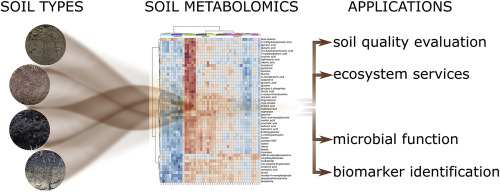Soil Biology and Biochemistry ( IF 9.7 ) Pub Date : 2020-02-17 , DOI: 10.1016/j.soilbio.2020.107758 Emma Withers , Paul W. Hill , David R. Chadwick , Davey L. Jones

|
Soils support a wide range of ecosystem services that underpin Earth system functioning. It is therefore essential that we have robust approaches to evaluate how anthropogenic perturbation affects soil quality and the delivery of these services. Metabolomics, the large-scale study of low molecular weight organic compounds in soil, offers one potential approach to characterise soils and evaluate the metabolic status of the soil biological community. The aims of the present study were to 1) characterise the soil metabolome across a contrasting range of soil types, 2) understand the relationships between common chemical and physical soil quality indicators and its metabolome, and 3) evaluate the discriminatory power of soil metabolomics and its potential use as a soil quality indicator. Nine different topsoils with 5 replications were collected along an altitudinal primary productivity gradient encompassing a wide range of soil types and land uses. Metabolites were extracted from soil using 3:3:2 (v/v/v) acetonitrile:isopropanol:water and individual compounds identified using a gas chromatography-mass spectrometry (GC-MS) platform. Overall, 405 individual compounds were detected, of which 146 were positively identified, including sugars, amino acids, organic acids, nucleobases, sugar alcohols, lipids and a range of secondary metabolites. The concentration and profile of metabolites was found to vary greatly between the soil types. Further, the soils’ metabolomic fingerprints correlated to a number of environmental factors, including pH, land-use, moisture and salinity. We also tentatively attributed soil-specific metabolites to potential functional pathways, although complementary proteomic, genomic and transcriptomic approaches would be needed to provide definitive supporting evidence. In conclusion, soil metabolomics offers the potential to reveal the complex molecular networks and metabolic pathways operating in the soil microbial community and a means of evaluating soil function. Further work is now required to benchmark soil metabolomes under a wide range of management regimes so that they can be used for the quantitative assessment of soil quality.
中文翻译:

使用非靶向代谢组学评估土壤质量和微生物功能
土壤支持着广泛的生态系统服务,这些服务支撑着地球系统的功能。因此,至关重要的是,我们必须采用可靠的方法来评估人为干扰如何影响土壤质量以及这些服务的提供。代谢组学是对土壤中低分子量有机化合物的大规模研究,它提供了一种表征土壤和评估土壤生物群落代谢状况的潜在方法。本研究的目的是:1)在不同类型的土壤中表征土壤代谢组; 2)了解常见的化学和物理土壤质量指标与其代谢组之间的关系; 3)评价土壤代谢组学的歧视能力;以及其潜在用途作为土壤质量指标。沿一个主要生产力梯度的梯度收集了9种不同的表层土壤,它们有5个重复,涵盖了广泛的土壤类型和土地利用。使用3:3:2(v / v / v)乙腈:异丙醇:水从土壤中提取代谢物,并使用气相色谱-质谱(GC-MS)平台鉴定单个化合物。总体上,共检测到405种单独的化合物,其中146种被积极鉴定,包括糖,氨基酸,有机酸,核碱基,糖醇,脂质和一系列次级代谢产物。发现不同土壤类型之间代谢物的浓度和分布差异很大。此外,土壤的代谢组学指纹与许多环境因素相关,包括pH值,土地利用,湿度和盐度。尽管还需要互补的蛋白质组学,基因组学和转录组学方法来提供明确的支持证据,但我们也暂时将土壤特异性代谢物归因于潜在的功能途径。总之,土壤代谢组学提供了揭示在土壤微生物群落中运行的复杂分子网络和代谢途径的潜力,以及评估土壤功能的手段。现在需要进一步的工作来在各种管理制度下对土壤代谢组进行基准测试,以便将其用于土壤质量的定量评估。土壤代谢组学提供了揭示在土壤微生物群落中运作的复杂分子网络和代谢途径的潜力,以及评估土壤功能的手段。现在需要进一步的工作来在各种管理制度下对土壤代谢组进行基准测试,以便将其用于土壤质量的定量评估。土壤代谢组学提供了揭示在土壤微生物群落中运作的复杂分子网络和代谢途径的潜力,以及评估土壤功能的手段。现在需要进一步的工作来在各种管理制度下对土壤代谢组进行基准测试,以便将其用于土壤质量的定量评估。



























 京公网安备 11010802027423号
京公网安备 11010802027423号